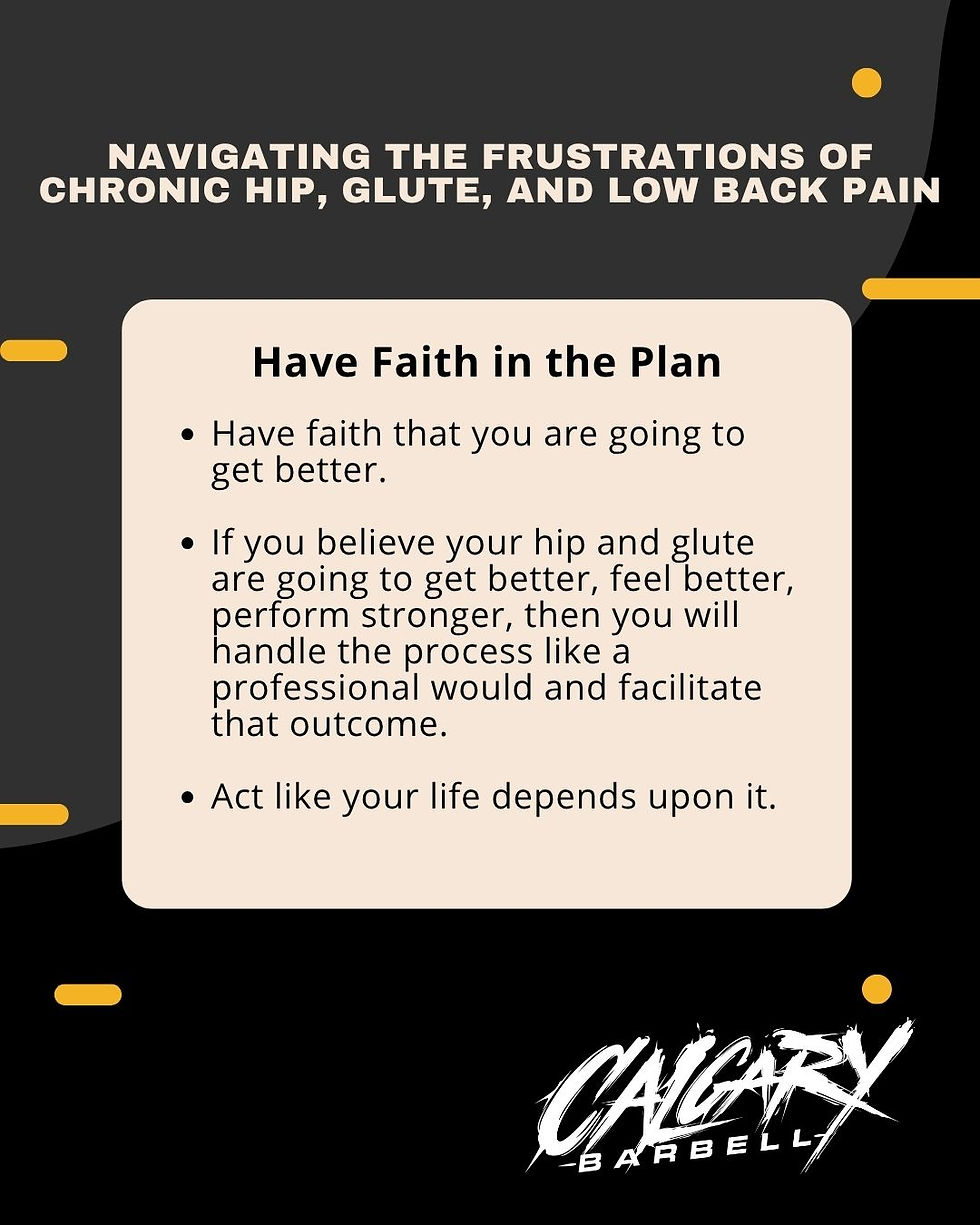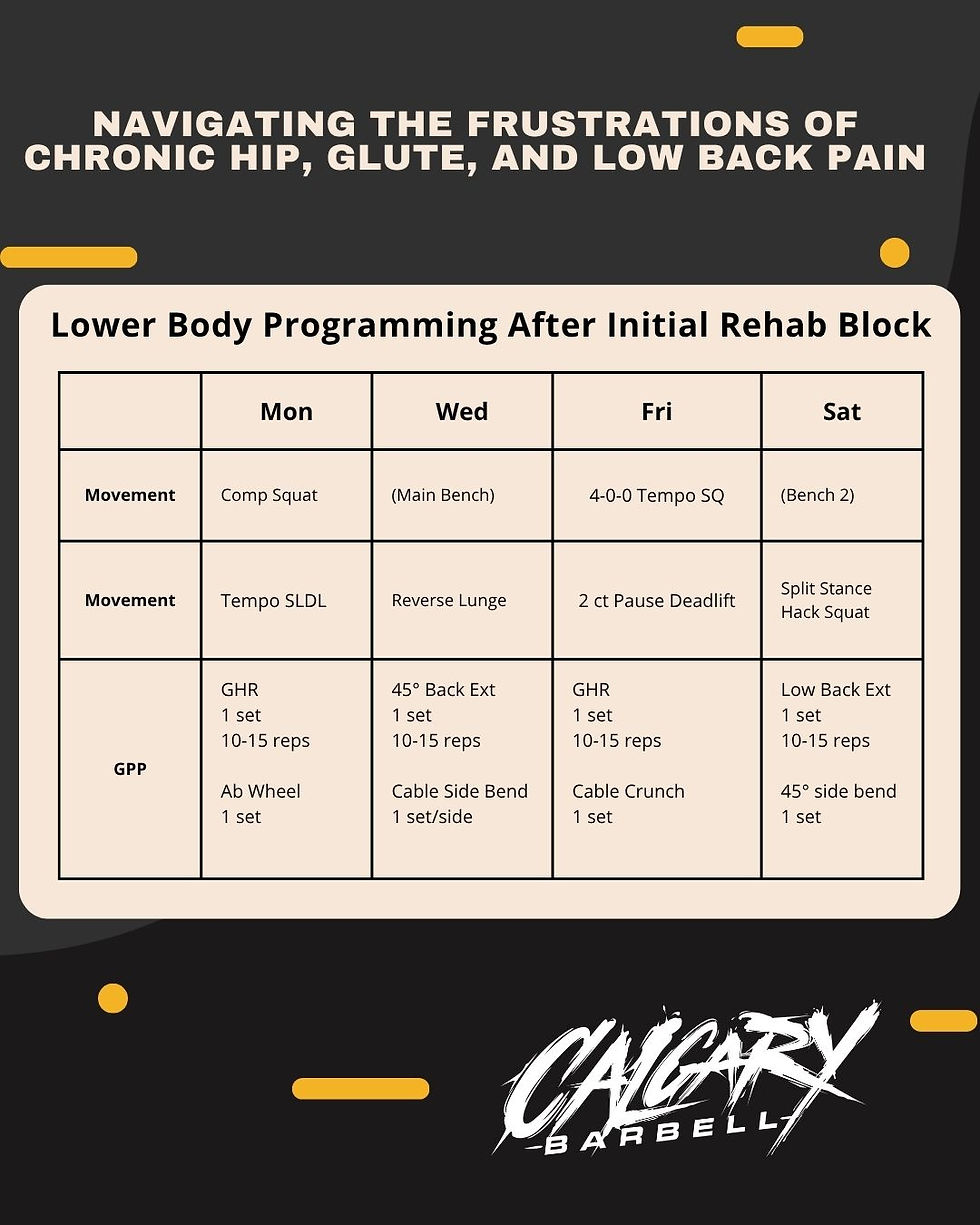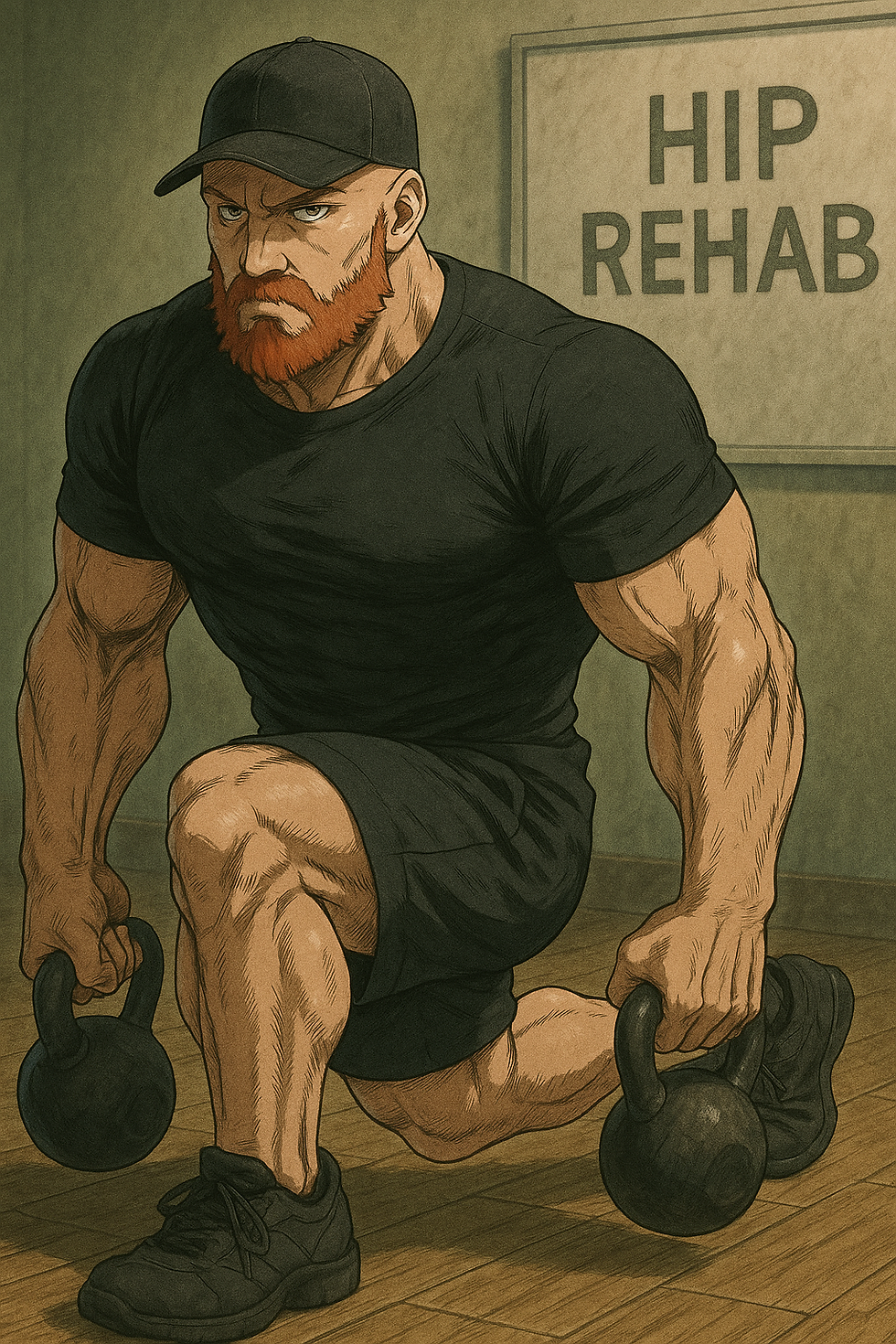Navigating the Frustrations of Chronic Hip, Glute, and Low Back Pain
- Taylor Shadgett
- Jun 25
- 11 min read
Updated: Jun 27

Setbacks

I tweaked my back again this morning. This time it was picking up a basket of laundry. It wasn’t even full. It was also on a day I was feeling good after doing my morning hip and lower back prehab drills. So good that I was trying to brace hard and practice my hinge. It wasn’t anything crazy, just a sharp zing! Enough for my disc to let me know it’s there. Coincidentally, or not, this comes just about 36 hours after my first squat session in months. The session itself went well, probably too well, so well that I went heavier than originally planned and overdid it slightly. Sounds like something I would do. The session itself was okay. The DOMs the next day was rough, but the psoas tightness and lateral hip pain on the hip I was supposed to be rebuilding was worse. This session came after a few months of trying to rebuild some single leg strength and balance, many pain-free sessions, and reaching lunge and split squat weights that I deemed it appropriate enough to return to 1x/week squatting and maybe deadlifting. Well, it looks like deadlifting is probably off the table later this week. Or is it? Choose not to catastrophize in this moment. You tell your clients that progress is not linear every day, why would your return from injury be linear. The joy has always been in navigating the ups and downs of training and adaptation. This is just another opportunity for you to get better at using your navigation tools to get yourself back on course.

You know what you have been able to do over the last however many months getting back to the point where you could have a decent squat session. Keep doing those things, get back on the horse. Accepting that these little miss steps will happen and having a plan for them is the only acceptable course of action. Giving up isn’t going to make you feel better. Your body feels better when you move, this morning proves that. As frustrating as it is, you are going to have to keep moving. Sitting around makes your pain worse, and it isn’t going to heal that way. Motion is the Lotion. You’ve said it time and time again, and it’s never been more true. Accept this and will it to be true. Have faith that you are going to get better. If you believe your hip and glute are going to get better, feel better, perform stronger, then you will handle the process like a professional would and facilitate that outcome. You would act like your life depends on it. Well, it does!

You want to have kids. It’s not even some day anymore. You want to have kids now, and you want to be able to enjoy your life with them. To do that you are going to need to do everything in your power to make your hip healthier, stronger, more robust, and better yet more antifragile. Clearly this process has and will take longer than you think it will, and way longer than you want it to. Your logical brain knows that is fair. Undoing 13 years of competitive powerlifting training will not happen overnight. Not to mention all the training and destruction you rained down upon your structures playing 8 years football before that. You have been playing competitive sports, or lifting weights, or both since you were 9 years old. Your body doesn’t owe you anything. Any adaptations you do get from training will come slow, your rehab, re-patterning, and rebuilding processes will probably come just as slow unfortunately.
Compensation Patterns

If you have a movement compensation pattern you have developed and engrained over a long period of time, it will probably take just as long, or just as many new quality reps, to teach that compensation out. At this point that compensation is habit, and you need to undue an old habit and create a new one. On top of that, the injury or wear and tear created by that compensation pattern seems to get increasingly sensitive or fragile the more it sticks around. This isn’t to say it will always be there. There are some great lifters who have gone through some painstakingly frustrating injury rehab processes and come back to set new PRs and even world records. Taylor Atwood’s PR return to the platform comes to mind.

Bryce is an amazing example of this as well. From my many conversations with Bryce over the last 8 or so years it seems like he is always dealing with these ups and downs. He accepts the state he is in and does every little thing he can to claw back on to the platform and lift himself to new heights. No one else truly knows about the hours, days, months, and years where it hurts just to live in his body. Everyone forgets about the time he spent doing lame ass light goblet squats because that is all that his knee could handle. Watching his training sounds like popcorn is being made. All the effort both he and his coach put into contingency planning and adaptability knowing that the day he can show up at the gym and perform well may be hit and miss and having a framework for navigating that problem.
Stay Calm and Patient

It’s 24 hours later now, 60 hours after squatting on Monday, and I ended up being able to train last night. Throughout the day I was in pain yesterday, but I stayed calm and committed to going to the gym and going through my prehab warmup routine and by the time I finished I was feeling much better. The only lower body work I had programmed for that session was one set of Reverse Lunges and two sets of easy bodyweight 45-degree back raise. Funny thing is that after the heavier lunges my hip felt indestructible for the rest of the day. The human body is an amazing adaptable organism and the way we process pain is so complex. My current day to day thought process is anchored around moving well in everything I do but also pushing my brain to being comfortable moving into and out of the positions that cause me, or have caused me, grief. Intuition might have told me to just rest and not even enter the gym yesterday, here I am on Thursday, and my hip is feeling the best it has since I squatted Monday evening. Anyone who was dealt with and managed their way through chronic pain knows that there will be ups and downs in the way your injury is feeling, but the ups and downs often do not make any sense. Waking up after a day of rest but feeling much worse can be very confusing. Going to the gym on a day full of pain and then performing well can be just as confusing. Some days you feel great but then you get under the bar and the pain shows up with next to no weight. The worst example is when you feel good, have a high-performance training session where technique feels good and is pain free, but then wake up the next day wondering if you will ever be able to powerlift again.
Here are the things I am doing right now to strengthen my weak glute and painful hip in attempt to get rid of a compensation pattern that led to a bulging disc.
Morning WD-40: Walk the Dogs (40 mins)

The majority of the pain, discomfort, and tightness I have felt throughout this entire process has almost always been first thing in the morning. Many of you will know that
I am a big advocate of powerlifters getting their steps in, hip and low back health being one of the main reasons for that. Walks are especially valuable for those of us dealing with chronic pain because we are too dumb to do any movements other than, squat, bench, and deadlift for years on end. Walking allows you opportunities to practice moving in the way that is pain free, while also navigating movements or positions that don’t feel as good. This time will also get blood moving in and out of your troublesome creaky joints hopefully lubricating your rusty ass. Unfortunately, I will also have to bend over to pick up dog poop, offering me another opportunity to practice moving well and seeing how problem positions feel from day to day.
General Hip Prehab – Morning (10mins)

These exercises were prescribed by my chiropractor after my initial visit. Of course, I have seen most of these exercises before, and was already doing some of them, as I am sure most of you have as well. The main goal behind this movement routine is to regain segmental control so that I stop hinging my spine instead of my hip. I was embarrassed to find out how much weaker my left side had become at some of them. I almost fell over trying to switch from my right to my left leg on marching glute bridges. While I know the idea of activation exercises has fallen out of favour, and people will say things like “If you can stand up there is no way that your glutes aren’t working”, and that is all fair. I am with you on all of that. I’d rather just start squatting the bar to warm up. Thing is some days it really does feel like my left leg does not work as well at both my hip joint and my ankle joint. Some days I am walking up the stairs and I must focus on stepping up and forward rather than stepping sideways. These exercises are helping me teach myself how to use my weaker muscles and getting myself comfortable working through range of motions that were weak and painful previously.
Varied Warmups (training days only)

The goal behind these movements is to mix and match loading different unilateral movement patterns on different sides of the body while also taking the body through a greater range of motion than is required for the sport. Focus on good bracing, controlled movement, and no hip shifting or compensation. Use this time to feel muscles work and good positive pathways. Pick two of these movements to do every session. The load does not have to be anything crazy, just something heavy enough that gives you feedback to brace against and resist. I use a 50lbs Kettlebell because I figure it will warm me up well enough to use a 45lbs bar.
Lower Body Programming for the first 10 weeks post major acute incident:

If squatting and deadlifting are out of the picture for the time being, then we need to find some healthier ways to train the muscles and joint actions involved in powerlifting. These movements will probably vary from person to person. The idea is that you find some lower body movements that feel good and pain free for you. They should still be challenging and hopefully they help expose the weakness you have been ignoring that brought you to this point in the first place.
Perfect Practice

After an initial block of trying to rebuild single leg strength in my injured leg it was time to start squatting and deadlifting again. I guess my overeagerness in load selection is potentially one of the things that got me here writing this blog in the first place. My plan since then has been straight forward: “Okay, you over did it, so smarten up, start lighter, build up perfect reps, even if you have to do sets of 1, and let the gainz take care of themselves.”
Nothing too special here. Deliberately slow and kind of boring, but that is okay. I feel like I can scratch my hard training itch with some of the single leg movements I have kept in my training. Honestly, some of the percentages are just the weights I happen to choose. Squat and DL singles starting at 405lbs, hoping to chip one set 10-20lbs per week and build that 1 perfect rep up slowly.

This honestly isn’t the way I would prefer to go about this, I would rather start with more reps at even lighter weight, but one of my main issues is my compensation pattern as sets go on, so I am trying to be smart about that and operate on the assumption that for now, 1 perfect rep is enough. It is going to take time to lift perfectly and without pain, so force the slow progression on the main comp lifts and let the gains come to you. Tempo Squat weights I am just trying to get better at squatting perfectly with 315lbs. And the plan with stiff leg deadlifts is to start at 225lbs and add 5-10lbs/week as long as I can. I plan to run this progression until I am touching 70%x1 and then reevaluating from there. Part of me thinks if I can get back to moving 80%x1 very well and pain free then I will be in a good enough spot to resume some kind of normal training progression again. For now, I have about 4 weeks of slow deliberate progression planned to really let my body heal and relearn how to brace well and lift without pain. Really, I need to lift at the speed that my weaker leg can keep up with.
General Stretching Routine (Evening, Non-Training Days – 20 mins)

This has been one of the things that I feel has kept me moving well enough over the last decade or so. If nothing else my stretching routine lowers perceptions of pain, makes me feel good, and aids in helping me wind down and fall asleep later in the evening. I stretch while I watch TV at night as a way of winding down physically and mentally.
Planned Rest

This is one of the most important tools in your recovery toolbox after sleep. Not only should this be worked into training with rest days and periods of lower stress, it should also be planned into your day-to-day life. This rest should be both physical and cognitive. Seriously, just go lay on the couch and watch tv or read a book. Hanging with a spouse, partner, or friends counts too. Whatever it is that you enjoy doing that lets you relax physically and mentally. I love the meme of the meathead who relaxes his brain by coming home and playing a stressful video game. The thing is if the video game is hard enough, the player is experienced enough, then the brain working on a task that is different from their day-to-day life and works stress, it can be restful. Almost like the video game is using all the CPU power so that there is no energy to focus on other work or stress. The same can be said for those of us that play an instrument, read a good book, draw, or just love to immerse ourselves in a great movie. I try to just chill out on the couch after I stretch. Lately Sam and I have been working out way through Friends, I have never watched it before, Sam loves it, it makes us laugh, and we don’t have to think about what to watch in the evening. It isn’t really what I would choose to watch, Sam makes fun of me because I talk about wanting to watch TV to wind down but the types of shows I would choose if I was by myself would be super high stress shows like Homeland, Ozark, or Peaky Blinders. Give me something so stressful and different from my life that I find it unrelatable and it flips a switch in my brain allowing me not to think about work or things like that later in the day.
At the end of the day our bodies are adaptive organisms that will respond the stressors placed on it. If you are dealing with chronic pain and injury, step towards the threat, but be smart about it. Consistency is everything. You probably won’t PR tomorrow, but you got yourself here through death by 1000 cuts. It will take time and effort to heal all those cuts. Stay faithful and deliberate in the plan. Motion is the Lotion, 700lbs ain’t gonna squat itself.





Comments